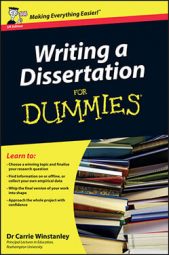A dissertation is just an important sounding name for a long essay – based on your own research. Writing a dissertation is an exciting, challenging, rewarding and often wonderful experience. At the same time it can be exhausting, time-consuming, frustrating and exasperating.
The main parts of your dissertation
Most dissertations follow the same basic structure and are made up of five parts: an abstract, introduction, methods and discussion, conclusions and references. Although the exact detail of each part can vary (such as the numbers of words allowed in the abstract), the inclusion of each part is standard and fixed. I like to compare the structure of a dissertation with the composition of an orchestral work – broadly your dissertation having a prelude, main movements and a finale. A great musician gets an encore too – and so does a great dissertation.
Research – Pick up your information!
If you’ve settled on your research topic – well done! Now you need to turn detective – searching for and gathering all the information you can to support and prove your theories. Now is the time for collecting together and examining the literature in your field of study; information from far and wide – as well as on your doorstep.
Getting to grips with the bewildering range of resources is quite a task in itself as there are different kinds of information available. By hotfooting it to your university library to going online and surfing the World Wide Web, you may well find all the information you need.
Then writing up a non-empirical dissertation is likely to be a rewarding experience. A non-empirical, or theoretical, dissertation doesn’t have any data you’ve generated at all. You won’t have interviews, questionnaires or observations to present but you do need to manage the structure and flow of argument effectively so that the conclusion is logical and the finished piece is coherent and clear.
Examiners want to be able to follow up any reference in your work by simply flipping to the bibliography and seeing all the information you’ve used in a clear and recognisable format.
Students often get into a spin about bibliographies and referencing. But creating a good bibliography is a pretty easy way to gain points. A well-crafted list of sources is an expectation and prerequisite for getting a decent grade. Not attending to the bibliography and references is a really pointless way to work and you’d be foolish not to spend time on this task.
Here are ten things to check before you bind your dissertation:
Watch your spelling and grammar
Get the pagination right
Spell your supervisor’s name correctly
Proofread your bibliography painstakingly
Avoid last-minute changes
Thank everyone who helped
Make your material anonymous
Make your section titles clear
Double-check the binding and submission details
Work out your journey to the submission place

